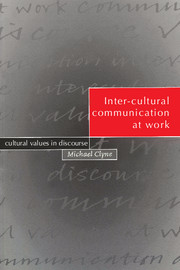Book contents
- Frontmatter
- Contents
- List of figures
- List of tables
- Acknowledgements
- 1 Introducing the field
- 2 Setting up the project
- 3 Speech acts in inter-cultural discourse
- 4 Variation in communication patterns and inter-cultural communication breakdown in oral discourse
- 5 Written discourse across cultures
- 6 Towards a linguistics of inter-cultural communication
- 7 Some theoretical and practical implications
- Appendix 1 Non-key informants
- Appendix 2 Index of informants' pseudonyms, ages, and ethnolinguistic background
- Appendix 3 Two long transcriptions
- References
- Index of text transcriptions
- Index of names
- Index of subjects
5 - Written discourse across cultures
Published online by Cambridge University Press: 05 June 2012
- Frontmatter
- Contents
- List of figures
- List of tables
- Acknowledgements
- 1 Introducing the field
- 2 Setting up the project
- 3 Speech acts in inter-cultural discourse
- 4 Variation in communication patterns and inter-cultural communication breakdown in oral discourse
- 5 Written discourse across cultures
- 6 Towards a linguistics of inter-cultural communication
- 7 Some theoretical and practical implications
- Appendix 1 Non-key informants
- Appendix 2 Index of informants' pseudonyms, ages, and ethnolinguistic background
- Appendix 3 Two long transcriptions
- References
- Index of text transcriptions
- Index of names
- Index of subjects
Summary
The cross-cultural study of written discourse
Although the present study is concerned with spoken discourse, I would like to discuss here some cross-cultural studies of written discourse, including ones which I have undertaken, as they may help to illuminate some relations between discourse and cultural values systems which will be taken up in Chapter 6 and particularly in Section 6.3. I will focus here on studies of coherence rather than of cohesion, in expository, not narrative discourse as it is here that the link with cultural values rather than linguistic structures is strongest. As written discourse is not the focus of the present study, I will restrict myself to some examples of the field.
For shorter, and particularly narrative texts, Givón (1983) has developed a quantitative model for cross-language discourse analysis to measure topic continuity (thematic, action, and topics/participants continuity) in discourse. This method is employed to analyze texts in eight languages of varying types. The measures used are: referential distance (the gap between the previous and current occurrence of the topic, up to 15 clauses); potential interference (the disruptive effect of other references on topic availability and identification, measured in the number of NPs (in 1 to 5 clauses to the left) with an argument comparable to the one under consideration), and persistence (the continued presence of a topic/participant as a semantic argument – in up to 5 successive clauses to the right).
- Type
- Chapter
- Information
- Inter-cultural Communication at WorkCultural Values in Discourse, pp. 160 - 175Publisher: Cambridge University PressPrint publication year: 1995

